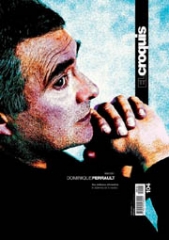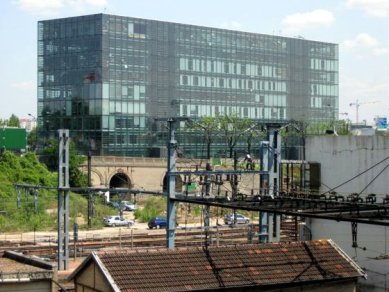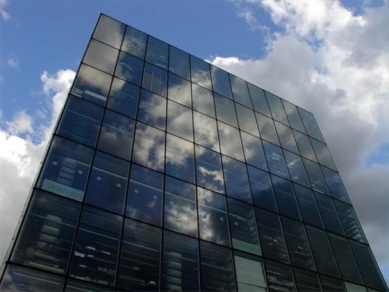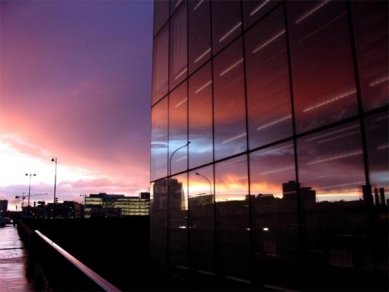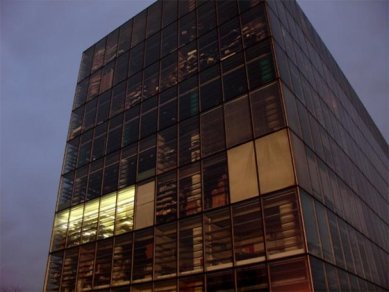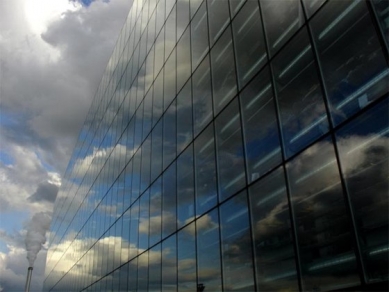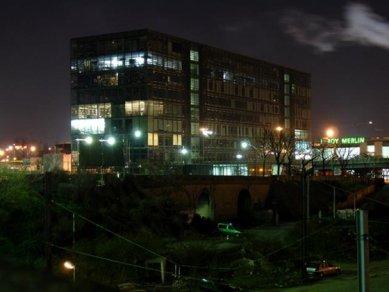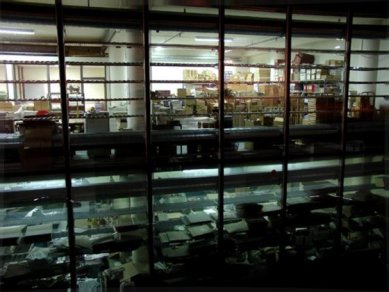
Industrial Hotel Berlier

In 1986, the city of Paris organized a competition for the development of "that small remaining piece of land between the highway ring surrounding central Paris (Boulevard Périphérique), Boulevard Masséna, and the enormous railway yard of the nearby Gare d'Austerlitz."
The program was not precisely specified, but it was to be a new type of building that could absorb various small operations typically scattered in single-story structures on the outskirts of cities around the world.
The winning design by Dominique Perrault, a glass brick equipped with all the comforts of the modern world, is a kind of harbinger of MVRDV's dreams of a compact periphery. This commission seemed tailor-made for Perrault. He has often mentioned in interviews that he does not consider the Champs-Elysées to be the most beautiful street in the world, but rather the Périphérique, along whose perimeter all the experiments of French architecture in the 20th century have alternated—from the Parc des Princes stadium to the Parc de la Villette. Drawing on the Roman lesson about the power of objects of simple geometric shapes, contained in Le Corbusier's key book Vers une architecture (which has just been published in Czech for the first time in over 80 years thanks to Petr Rezek), Perrault designed his "butter cube in the middle of a pot full of spaghetti," as he likes to say.
After four years, in 1990, DP completed his first realization within the heart of Paris and immediately moved his office into the penultimate floor of this 10-story building, where it still operates today (but will relocate to the 11th arrondissement next year). The building itself is remarkably simple, and it's hard to describe what constitutes its distinctive charm. It is a primitive reinforced concrete skeleton, clad in glass panels across the entire facade. The dimensional system used by Perrault's office for constructing its most famous realization—the BnF (French National Library)—is identical. It is located close to the Hotel Berlier, and thus Perrault could observe its entire construction from the windows of his office. Open and, apart from the reinforced concrete columns of slightly elliptical (!) shape— which immediately reminded me of the facade columns of the Zlín 21 building—the undisturbed space of each floor, measuring approximately 70x25 meters, is intersected in the first and third quarters by a lift and staircase core. Its presence is only manifested from the outside by the absence of air conditioning ducts, which otherwise accompany the floor and ceiling of each level, and the movement of elevators with large circular openings, which allow for a wonderful view of the incredible traffic flows in the surroundings (e.g., 250,000 cars daily on the Périphérique).
The most characteristic feature of the entire building is probably the internal horizontal sunshades (5 rows on each floor) made of bent steel sheets, designed to carry considerable weights. These sunshades—living proof of Murphy's Law that every free horizontal surface will eventually be completely filled vertically—have been transformed by the various tenants into shelves carrying a variety of items. However, this has only increased their ability to block sunlight from penetrating into the depths of the interior, and thus the additional roller blinds are only drawn in a small portion of the building.
Only through careful observation can one uncover the architect's interventions that distinguish this building from the category of Zero Degree Architecture (as Rem Koolhaas calls architecture with a "typical floor plan"). The ground floor and especially the top floor have a greater headroom than the other levels (how negatively the opposite effect can manifest on the facade can be well seen in the building of the Czech Radio in Prague on Balbínova Street by ADNS). Similarly, the corner glass panels are always a bit wider than the rest.
It is almost unbelievable how differently one building can appear depending on varying atmospheric conditions (see the attached photographs). From complete transparency to utter opacity.
Fifteen years after completion, the Hotel Berlier shows only minor signs of aging. Even the extraordinarily massive steel sunshades in some places have not withstood the expectations placed upon them by especially extreme tenants, and one broken glass panel was replaced with a plywood board at the entrance. Otherwise, in my opinion, Perrault's best realization remains untouched.
The program was not precisely specified, but it was to be a new type of building that could absorb various small operations typically scattered in single-story structures on the outskirts of cities around the world.
The winning design by Dominique Perrault, a glass brick equipped with all the comforts of the modern world, is a kind of harbinger of MVRDV's dreams of a compact periphery. This commission seemed tailor-made for Perrault. He has often mentioned in interviews that he does not consider the Champs-Elysées to be the most beautiful street in the world, but rather the Périphérique, along whose perimeter all the experiments of French architecture in the 20th century have alternated—from the Parc des Princes stadium to the Parc de la Villette. Drawing on the Roman lesson about the power of objects of simple geometric shapes, contained in Le Corbusier's key book Vers une architecture (which has just been published in Czech for the first time in over 80 years thanks to Petr Rezek), Perrault designed his "butter cube in the middle of a pot full of spaghetti," as he likes to say.
After four years, in 1990, DP completed his first realization within the heart of Paris and immediately moved his office into the penultimate floor of this 10-story building, where it still operates today (but will relocate to the 11th arrondissement next year). The building itself is remarkably simple, and it's hard to describe what constitutes its distinctive charm. It is a primitive reinforced concrete skeleton, clad in glass panels across the entire facade. The dimensional system used by Perrault's office for constructing its most famous realization—the BnF (French National Library)—is identical. It is located close to the Hotel Berlier, and thus Perrault could observe its entire construction from the windows of his office. Open and, apart from the reinforced concrete columns of slightly elliptical (!) shape— which immediately reminded me of the facade columns of the Zlín 21 building—the undisturbed space of each floor, measuring approximately 70x25 meters, is intersected in the first and third quarters by a lift and staircase core. Its presence is only manifested from the outside by the absence of air conditioning ducts, which otherwise accompany the floor and ceiling of each level, and the movement of elevators with large circular openings, which allow for a wonderful view of the incredible traffic flows in the surroundings (e.g., 250,000 cars daily on the Périphérique).
The most characteristic feature of the entire building is probably the internal horizontal sunshades (5 rows on each floor) made of bent steel sheets, designed to carry considerable weights. These sunshades—living proof of Murphy's Law that every free horizontal surface will eventually be completely filled vertically—have been transformed by the various tenants into shelves carrying a variety of items. However, this has only increased their ability to block sunlight from penetrating into the depths of the interior, and thus the additional roller blinds are only drawn in a small portion of the building.
Only through careful observation can one uncover the architect's interventions that distinguish this building from the category of Zero Degree Architecture (as Rem Koolhaas calls architecture with a "typical floor plan"). The ground floor and especially the top floor have a greater headroom than the other levels (how negatively the opposite effect can manifest on the facade can be well seen in the building of the Czech Radio in Prague on Balbínova Street by ADNS). Similarly, the corner glass panels are always a bit wider than the rest.
It is almost unbelievable how differently one building can appear depending on varying atmospheric conditions (see the attached photographs). From complete transparency to utter opacity.
Fifteen years after completion, the Hotel Berlier shows only minor signs of aging. Even the extraordinarily massive steel sunshades in some places have not withstood the expectations placed upon them by especially extreme tenants, and one broken glass panel was replaced with a plywood board at the entrance. Otherwise, in my opinion, Perrault's best realization remains untouched.
The English translation is powered by AI tool. Switch to Czech to view the original text source.
0 comments
add comment


